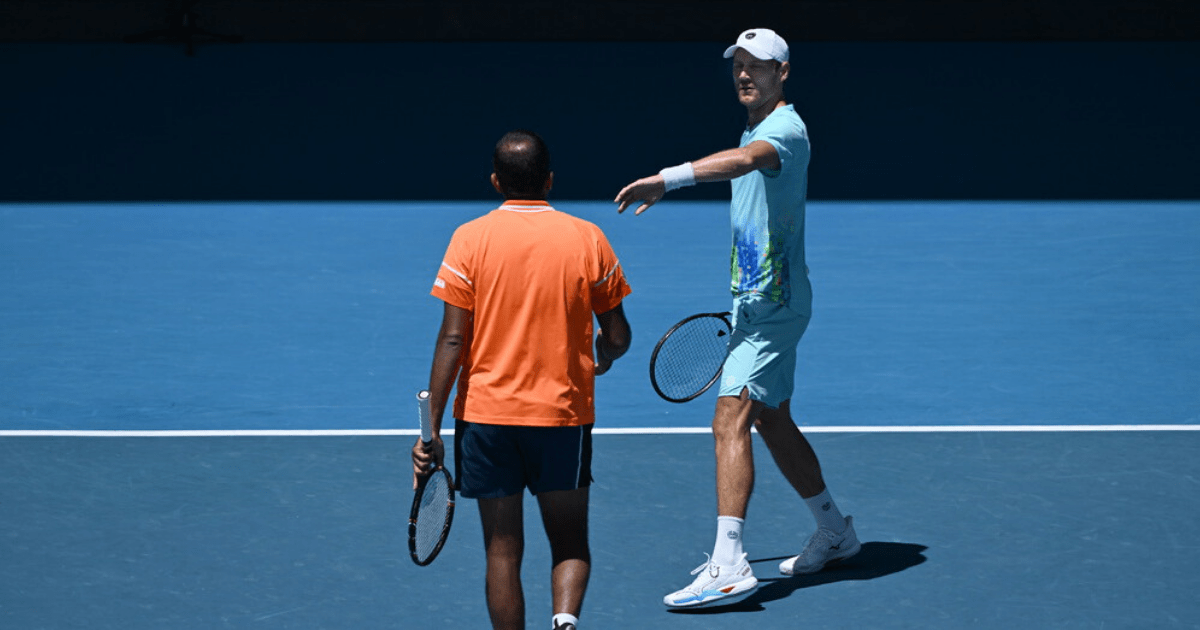Strange Incident Forces Match to be Moved Courts
An Australian Open doubles quarter-final match was disrupted this morning when the court surface began "bubbling." Players Rohan Bopanna and Matthew Ebden were competing against Maximo Gonzalez and Andres Molteni on Court 3 when the bizarre incident occurred.
Oldest World No.1 Title on the Line
Rohan Bopanna, 43, had the opportunity to become the oldest ever world No.1 with a victory in this match. However, the players had to navigate the unusual circumstances caused by the bubbling court surface, which prevented the ball from bouncing properly.
Commentator Sheds Light on the Situation
Commentating on the match, former Australian favorite John Millman explained that bubbling on hard courts can occur when moisture gets trapped underneath the surface. This affects the bounce of the ball and can make it difficult to play. Millman also mentioned that similar issues have been seen in the past at the US Open.
Match Relocated to Margaret Court Arena
The bubbling issue was noticed just three games into the match, with Gonzalez and Molteni leading 2-1 on serve. The contest was temporarily halted and later resumed on Margaret Court Arena. Bopanna and Ebden ultimately won the match 6-4, 7-6(5), securing a spot in the semi-finals where they will face Zhang Zhizhen and Tomas Machac.
Frequently Asked Questions
What are key elements of tennis etiquette?
Tennis etiquette reflects sportsmanship and respect. Players are expected to make honest calls on line rulings, avoid distractions during serves, remain silent during rallies, and shake hands cordially after the match. The audience can also follow this etiquette, by staying quiet and applauding both players’ good shots. By adhering these unwritten tennis rules, you maintain the gentlemanly tradition and integrity of the sport.
How has tennis evolved over the years?
Tennis equipment has changed dramatically since the early days of tennis. Original rackets are made from solid wood, with string gut that is made from animal intestinal fibers. As technology evolved, rackets became lighter and stronger by using new materials, such as carbon fiber, graphite, and titanium. The balls have also changed, transitioning from hand-sewn to manufactured pressurized rubber that provides consistent bounce and flight. The evolution of the game has resulted in a more dynamic, athletic play.
What are the effects of playing surfaces on tennis?
Tennis matches have a huge impact on their style and pace due to the different surfaces. Grass courts favor big servers and players with an aggressive style. Clay courts have a slower ball speed and a higher bounce. They are better for players with tenacity and topspin. Hard courts are a good choice for players with a wide range of skills, as they provide a level playing field. These variations in surfaces necessitate different strategic approaches and can heavily influence match outcomes.
What are the roots of tennis in history?
The origins of tennis can be traced back to the 12th century France. In monastery courtyards, monks would use their hands in a sport called jeu de pâume to hit the ball. Over time rackets and other equipment were added, and the sport evolved into what is known today as Tennis. The game was popularized by the European nobility in the 16th century. Tennis has seen many changes over the years, such as the introduction of lawn-tennis in the nineteenth century and the standardization of rules.
Who has been credited with standardizing modern tennis?
Major Walter Clopton Wingfield owes a lot to the modernization of tennis. In 1873 Wingfield invented a new version of tennis, called Sphairistike. The game was played on a grass hourglass court. Wingfield’s version of the game included a simplified scoring system and the equipment that is similar to what is used today. This version of the game laid the foundations for modern lawn tennis rules. By 1877 the first Wimbledon Championships was held, cementing its rules and structure.
Statistics
- Since the Open Era began in 1968, allowing professional players to compete in the Grand Slams, the United States has produced the most Grand Slam singles titles across men’s and women’s competition.
- Graphite became a popular material for tennis racquets in the 1980s, with over 90% of professional players now using graphite or graphite composite racquets.
- The International Tennis Federation (ITF) governs over 200 nations, indicating the sport’s vast international governance structure and participation rate.
- The four Grand Slam tournaments collectively attract over 3.5 million spectators in person, highlighting tennis’s enduring appeal.
- Professional tennis players can serve the ball at speeds exceeding 150 mph, with the fastest serve recorded at 163.7 mph by Australian player Sam Groth in 2012.
External Links
bbc.com
tennis.com.au
itftennis.com
worldtennismagazine.com
atptour.com
How To
Tennis Shoes: How to Choose the Right Shoes for your Court Surface
Tennis shoes should be chosen according to the type of court surface you primarily play on. Players of hard courts should choose durable soles that can withstand surfaces with abrasive materials. Clay court shoes usually feature a herringbone pattern for better grip and control. Grasscourt shoes have often nubs, or even pimples, on their soles. This provides traction without damaging your court. To reduce injuries and maximize movement on the tennis court, it is important to ensure that you are wearing shoes with proper support and fit.

